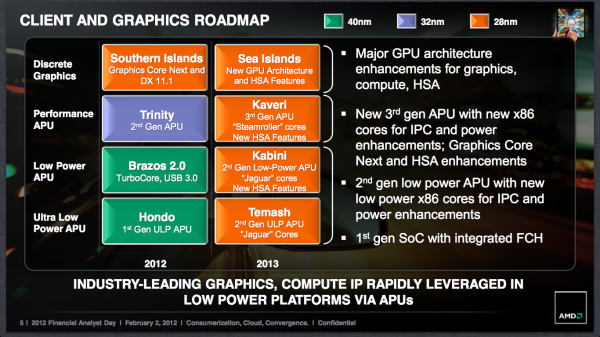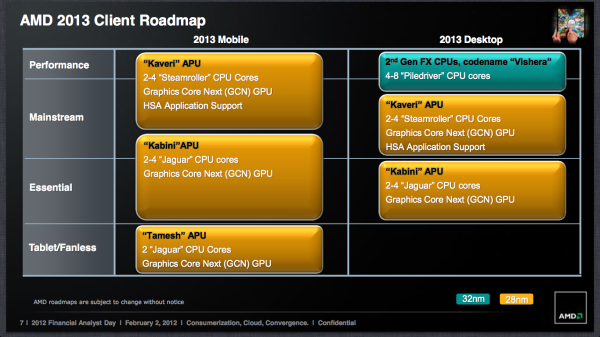Understanding AMD's Roadmap & New Direction
by Anand Lal Shimpi on February 2, 2012 6:16 PM EST- Posted in
- CPUs
- AMD
- Trade Shows
- AMD FAD 2012
We've been providing live coverage of AMD's 2012 Financial Analyst Day from Santa Clara today, but if you want a summary of the company's strategy under new CEO Rory Read you've come to the right place. Below you'll find links to everything we've published from AMD's FAD 2012:
AMD's Rory Read Outlines AMD's Future Strategy
AMD Outlines HSA Roadmap: Unified Memory for CPU/GPU in 2013, HSA GPUs in 2014
AMD is Open to Integrating 3rd Party IP in Future SoCs
AMD's Financial Analyst Day 2012 - Mark Papermaster, SVP & CTO Presentation
AMD: Flexible Around ISA
AMD Nods at Shorter Design Cycles, More Synthesized Designs
What AMD Views as Important: Tablets, Servers, Notebooks & GPUs
AMD & Compal Show Off 18mm Trinity Notebook
AMD's 2012 - 2013 Client CPU/GPU/APU Roadmap Revealed
AMD's 2012 - 2013 Server Roadmap: Abu Dhabi, Seoul & Delhi CPUs
AMD is Ambidextrous, Not Married to Any One Architecture, ARM in the Datacenter?
AMD's Tablet Architectures: Hondo at 4.5W, Future Sub-2W SoC
The name of the game for AMD in 2012 is execution. Far too often at previous AMD events we'd see a roadmap with no indication of whether or not AMD would actually stick to it. Plans were always aggressive and made sense, but execution rarely mirrored what was promised on paper. AMD in turn ended up delivering CPUs sometimes years after they were promised, which obviously didn't help grow the company.
Over the past few months Rory and his new management team at AMD have been restructuring the company to improve execution. As a much smaller company than Intel, AMD had an almost impossible task competing in the x86 space, but AMD should have also been far more agile than it was given its size. AMD's restructuring is supposed to fix these agility and execution problems. The proof will be in how well AMD is able to introduce products over the next 24 months.
As far as the roadmap goes, AMD already laid out what it hopes to accomplish by 2013. The best way to summarize AMD's next two years is: APUs and servers. On the APU side, we'll get updates to all of the current lines this year (Trinity & Brazos 2.0), but we'll also get a new 4.5W APU (Hondo) aimed at the Windows 8 tablet market. Now 4.5W is a bit high for a tablet but AMD has plans to bring even lower power architectures to market in the future. Next year we'll also see the first single-chip solutions from AMD: Kabini and Temash will integrate the I/O controller (SATA, USB ports, etc...) on-die. Intel is doing something similar with Haswell.
The big transition will happen next year, as AMD moves its entire APU stack from 32nm SOI to a bulk 28nm process at Global Foundries. This is an important move as it signifies the use of more easily synthesized designs, which enables AMD to bring out APUs in a quicker fashion and with lower design costs. Effectively everything follows the path laid by Brazos/Bobcat at this point. Note that AMD will be shipping 28nm APUs while Intel is well transitioned to 22nm, a gap that AMD has no intentions on narrowing. The process technology gap has almost always existed between AMD and Intel, but now AMD is taking a firm stance in saying that it has no intentions to blindly pursue the closing of that gap.
What once was a 3+ year design cycle for AMD CPUs and APUs now shrinks to less than 24 months (maybe even as short as 18 months) as a result of this migration to more easily synthesized designs. If this sounds a lot to you like the old GPU design cadence don't be surprised. AMD's APUs are, after all, largely made of GPU transistors that have always strayed from custom logic where possible. The big change is simply doing more non-custom x86 design.
Obviously AMD's ability to execute on this roadmap will depend heavily on Global Foundries delivering good yields at 28nm, however AMD does seem fairly confident at this point. That being said, 2013 is a very broad timeframe. Executing on the above roadmap sooner rather than later in 2013 will be the difference between a competitive AMD and one that's quickly written off.
I don't believe a move towards easily synthesized architectures is necessarily a bad thing. As long as AMD can deliver good performance at competitive prices the process technology really doesn't matter as much. Typically process technology was used as an enabler of good performance but as a newly fabless semiconductor, that strategy doesn't necessarily apply to AMD - at least not across all market segments. In other words, what works for Intel may not work for AMD.












84 Comments
View All Comments
haplo602 - Friday, February 3, 2012 - link
Funny how AMD anticipated some of my changes in hardware preference. I moved to a socket F dual opteron board. in 2 years time, I'll change it for another dual opteron board.The other end goes into my living room as a HTPC next to the TV for the wife (Internet) and kids (low end gaming).
R3MF - Friday, February 3, 2012 - link
i am disappointed in their desktop roadmap.ditching sepang/terramar means no on-die PCIe 3.0 controller, and relying on an aging chipset stuck with off-die PCIe 2.0. also means no triple-channel memory in the enthusiast space either.
and not only for 2012, but for much of 2013 as well!
R3MF - Friday, February 3, 2012 - link
steve from H thinks its AM2, which i believe the socket that high-end desktop will migrate too from AM3+ next year, so good upgrade path.but is he right?
and am i right?
BPB - Friday, February 3, 2012 - link
The simple fact of the matter is the vast majority of folks today don't need anything near high end CPUs. If you are gaming at 1920x1200 or lower, middle of the road cpus and gpus do the trick fine. From what I've read most folks are 1920x1080 or lower, with many at 1680x1050 or lower. My 3 year old AMD box does fine for almost all current games (1920x1200). It's only a couple that recently came out that have me considering a new video card. Even then I'll probably get a 6800 series from AMD, unless a cheaper 7000 series card comes out soon.Yuriman - Sunday, February 5, 2012 - link
Very true, but Intel beats AMD in price/performance AND power/performance and the disparity is only going to grow if AMD keeps adding transistors on old processes. I'm glad AMD is ditching high end CPUs, there's a lot of R&D money there that would be of great benefit elsewhere.It's definitely time for both companies to start building down. I want a netbook that doesn't suck, and since the PC gaming market is so stagnant, any gaming PCs I build will likely be small, quiet, and sip power.
rocketbuddha - Friday, February 3, 2012 - link
Anand, did you get clarity from AMD as to what would be the non-SOI 28nm node to be in use?GF or TSMC?
If Brazos 2.0 is going to be in 40nm then that means that AMD mistakenly bet that GF 28nm will be ready in 2012. Else what is the use of introducing Brazos 2 in 40nm node while TSMC 28nm is now manufacturing Krait and soon TI OMAP5.
So AMD either can trust GF will get 28nm in 2013 or use TSMC 28nm (which it has some familiarity manufacturing Discrete Graphics chips). Last year there were some articles in Extremetech by Joel Hruska
http://www.extremetech.com/computing/106217-manufa...
as to AMD going to TSMC for 28nm non SOI APU manufacturing..
If true Jaguar series will be 28nm TSMC HKMG, while for Kaveri (Trinity successor) as well as BD2 and successors AMD has no choice but to use GF SOI processes.
Assuming that Steamroller is BD2, Piledriver is enhanced BD, looks like even in 2013 AMD expects the best SHP SOI process available at Global Foundries would be 28nm. Man! and Intel is supposed to go to 22nm in the middle of this year. Even in 2013 AMD is not sure GF would have a 20nm SOI node ready. Sucks! Let us hope STMicro comes close enough to providing AMD with a choice of foundries.
sapi3n - Friday, February 3, 2012 - link
I built a phenom II X6 and AMD 5870 system w/ 16 gigs ram, an SSD, and several 1TB drives, which does crunch pretty well in After Effects, but I wasn't able to get an HDMI capture card to work (Blackmagic prefers intel?) - so do not have that capability, no Mercury Engine Playback support in Premiere (Cuda only), and no 64-bit firewire support on the motherboard (the Asus M4A89TD- Pro's integrated ports do not work with my camera) - very frustrating to have all these problems that wouldn't exist with an intel/nvidia build.jabber - Friday, February 3, 2012 - link
So what you are saying is...you didn't do your homework?Not really the fault of AMD is it?
sapi3n - Saturday, February 4, 2012 - link
no way to test blackmagic without taking the plunge - by the way their support is horrible - fair warning - otherwise, i was under the impression that all cards with current open GL specs would help accelerate Adobe software, which is true - but premiere's mercury playback engine is cuda only - if i'd have known that, I would have purchased differently.sapi3n - Saturday, February 4, 2012 - link
what about buying a game that has physX support, with features turned off for your $500 AMD card - you're fu$$ed.